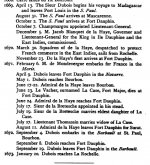Taphrospilus
Well-known member
Small remark on HBW Alive entry as per today:
No doubt they are dedicated to Alphonse Joseph Charles Dubois.
I assume the year of death 1921 might came from here page 98. But from obituary here I checked here. There is written:
For me it is not clear when Fascicule II (part 2) was published? Was the publishing date before or after 1st June 1921 when he died? Or does Laurent Coopman mean 1st of June 1920?
Here is written:
So we know Dubois was born 18th October 1839 in Aachen and he was in his 82 year (means he was still 81??).
OK after writing all this the death date must be indeed 1921 as he was 81 years on 18th October 1920 (I have had some doubts before). Or anyone can proof me wrong with my analysis e.g. as my reading of the french text is wrong?
● Dr Alphonse Joseph Charles Dubois (1839-1921) Belgian zoologist (subsp. Bycanistes fistulator, subsp. Ploceus melanocephalus).
No doubt they are dedicated to Alphonse Joseph Charles Dubois.
I assume the year of death 1921 might came from here page 98. But from obituary here I checked here. There is written:
Il s'est éteint doucement, sans heurt, dans sa quatre-vinght-deuxième année, le 1er juin dernier, en sa villa de Coxyde-sur-Mer, qu'il n'a pas quittée de toute la durée de la guerre.
For me it is not clear when Fascicule II (part 2) was published? Was the publishing date before or after 1st June 1921 when he died? Or does Laurent Coopman mean 1st of June 1920?
Here is written:
Alphonse Dubois naquit lui même à Aix-la-Chapelle, le 18 octobre 1839, et l'année suivante son père, Charles-Fréderic Dubois, le savant ornithologiste, vin s'établir à Bruxelles avec sa jeune famille.
So we know Dubois was born 18th October 1839 in Aachen and he was in his 82 year (means he was still 81??).
OK after writing all this the death date must be indeed 1921 as he was 81 years on 18th October 1920 (I have had some doubts before). Or anyone can proof me wrong with my analysis e.g. as my reading of the french text is wrong?





